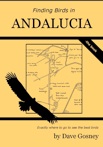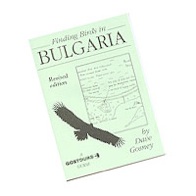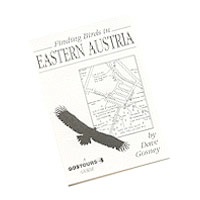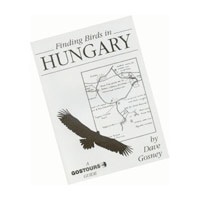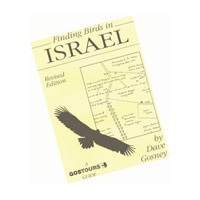Finding Birds in israel update
Eilat
Spring 1999. As predicted, the channel at site 2 is now usually dry and rather poor for birds. The surrounding scrubland has also been ruined as a bird habitat. At site 3, just north of the area labelled on my map as 'more saltpans' is now a new nature reserve and International Birdwatching Centre, the centrepiece of which is an excellent freshwater pool. In spring this attracts swarms of pipits and wagtails, worth checking for Citrine Wagtail and Buff-bellied Pipit plus dozens of hirundines including Red-rumped Swallows. This is the new location of the Ringing Station and good birds often turn up in their nets; Isabelline Shrike in spring 1999. In 1999 it wasn't an easy place to find but it may now be better signposted. The best route is to turn off the Arava highway near Kibbutz Elot, drive towards the Jordanian border post but take the last available track to the right (the one shown on my map which leads all the way to the beach). Almost as soon as you turn on to this track, look for an even smaller track, forking away to the right, by the obvious 'Dom' palm tree. Follow this track along the east side of the drainage channel (shown on my map) until you reach the car park. In the spring of 1999, a Semi-collared Flycatcher spent several days in this car park! Around the back of the date palms at site 5 are some piles of razor wire next to the Jordanian border. These are particularly favoured by Indian Silverbills. Site 6 is probably not as good or birds as it once was but can still be very good for Namaqua Doves. Site 7 has been completely planted up with vineyards and surrounded by massive polygauze windbreaks. This makes the area quite useless for birding - a terrible waste of an area that used to be superb. In theory, there is no access to the pond at site 8 but birdwatchers can sneak in via a hole in the fence at the North-west corner. As long as you behave sensibly, the locals don't seem to mind. In spring it is often good for pipits and wagtails (including Citrine). A few waders often stay here - it is one of the most likely spots for White-tailed Plover. The reservoirs at site 9 have become an excellent place for birds. They are best approached from the Arava Highway by turning East opposite the turn-off to Amram's Pillars. Follow this track to the end of the greenhouses and check for Namaqua Doves roosting in the last tree on the left. Beyond there you will see signs saying 'Military area - no access' but these are ignored by everyone (it's only the Middle East after all). It is then possible to drive all around the reservoirs, getting superb views of some of the waders such as Marsh and Broad-billed Sandpipers and Greater Sand Plover. If you are lucky you may also see flocks of duck here such as Garganey, Pintail and Shoveler but these get flushed by every birdwatcher who is selfish enough to drive along the embankments between the reservoirs (please keep to the outer embankments). At the South end of the main reservoirs are some smaller pools which can be excellent for crakes, especially Little Crake. The area of scattered acacias to the west of the northernmost reservoirs has been favoured by a Grey Hypocolius in the spring of 1998 and 1999. This is also a good spot for migrant Quails. For some years, the House Buntings have not been showing at site 12 - [ indeed they are no longer found in the south of Israel though there have been some sightings around En Gedi]. In late March, Syrian Serins are sometimes seen here and at the nearby Hume's Park, halfway between the cemetery and the pumping station. Wadi Schlomo (accessed between sites 2 and 3 on page 7) is one of the best wadis around Eilat and well worth checking for difficult birds such as Cyprus Warbler and Sinai Rosefinch. In some years there have been regular sightings of Verreaux's Eagle from site 3, page 7. (DG)
18th Feb 2008 At En Netaphim spring we saw 2 Desert Larks and a small flock of Sinai Rosefinch. In wadi Sclomo we had Striated Scops Owl and a Cyprus Warbler and on North beach there was both dark and pale morph Western Reef Heron and 3 Great Black-headed Gulls (Dave Horton in trip report on www.israbirding.com).
2nd April 2008 Black Bush Robin at the ICBE Birdwatching centre, the wintering Crested Honey Buzzard in the date palms and 2 Olive-backed Pipits which had also over-wintered. (Richard Bonser on www.freewebs.com/richbonser)
March 2009. Holland Park is a site on the outskirts of Eilat, bordering the desert but well-watered and planted with shrubs, making it excellent for migrants - although we failed to find the Black Bush Robin that had been present the previous day. We had more success with both Kittlitz's Plover and Caspian Plover at site 9 where we also turned up a Bimaculated Lark and had two Lichtenstein's Sandgrouse at site 8 at 18.15 on two nights (coming in near the black pipe on the north-western edge of the sewage farm pool). [They no longer visit the Water Pumping station at Eilat, so this is the new site] At Amram's Pillars we found two female Sinai Rosefinch approximately 50m along the track from the camping carpark (on the left hand side) and a male at the top car park. Birders put down food for the birds which at least attracts Desert Lark and Sand Partridge. We saw an Oriental Honey-buzzard over the International Birding Centre; this is a regularly wintering bird which roosts in the date palms. We struggled to find Indian Silverbill at site 5 but eventually saw some on the perimeter fence; we had Namaqua Dove there too. One way to get closer to the seabirds of North Beach is to take the glass-bottomed boat tour into the bay. This costs about £9 per person and briefly passes close to the offshore infrastructure on which birds often sit - but it was disappointing on our visit. (Owain Gabb and Tim Sykes - trip report on www.israbirding.com)
[To get to Holland Park, take the main road north out of Eilat but turn left at the last roundabout, then almost immediately right (at 29.5704N, 34.9623E). The park is at the end of this road.]
Ein Avdat
A gorge about 27 km North of Mizpe Ramon on the road (route 40) between Eilat and Nizzana. It is best approached from the North by turning right from the main road towards Ben Gurion college. From there you will see signs to Ein Avdat. The gorge has breeding Bonelli's Eagles and Eagle Owls and Wallcreepers sometimes winter here. Other birds to look for include Scrub Warbler, Sand Partridge and Griffon and Egyptian Vultures. The fields to the north of Ben Gurion College are worth checking for feeding sandgrouse (Black-bellied and Spotted). There has been some dispute regarding the identity of these Eagle Owls but local birders believe the birds here are intermediate between 'Eurasian' Eagle Owl and Desert Eagle Owl
23rd Feb 2008. A short walk from the car park half way up the canyon produced Bonelli's Eagle (Dave Horton - trip report on www.israbirding.com).
Arava Valley
March 98. At site 2 I found 5 Desert Warblers by turning left at the T-junction and searching the scrub on the left after two more pumping stations. There is now an artificial lake at site 3 which looks very promising for migrants including herons. (Ian Hillery)
Yotvata
March 99. At site 2, the gardens in the enclosure behind the visitor centre were superb for migrants, with birds such as Bluethroats, Wrynecks, flycatchers and warblers including a wintering Hume's (Yellow-browed) Warbler which had been there the previous year too. The acacia bushes here also continue further east and it is here that we found an Arabian Warbler (and Roland Brown found one the year before). We also had several sightings of Syrian Serin here but missed the Black Bush Robin that had been present for a few days. Site 3 is becoming overgrown so is less productive for wildfowl and supports only a few waders. However, both White-tailed Plover and Little Crake are sometimes seen here and the Dead Sea Sparrows are often present. The fields at site 4 are now mostly used for growing alfalfa which is great for birds such as pipits, wagtails and wheatears. In the spring of 1999 this was the best site for Oriental Skylark and a White-tailed Plover was present for several days. Kibbutz Lotan (site 7) continues to turn up rarities including, recently, Crested Honey Buzzard, Dusky Warbler, Hume's Warbler and Menetries's Warbler. Syrian Serins winter here and can be seen up to the end of March. This is an infinitely nicer place to stay than Eilat, with loads of migrants literally on your doorstep. (DG)
Feb 2008. I checked at least 15 territories where Arabian Warbler used to breed at least until the late 1990s but was unable to locate any apart from two pairs in the Hazeva area, 140 km north of Eilat (see below). They have disappeared from their previous sites around Eilat and Yotvata. This subspecies is on the verge of extinction (Hadoram Shirihai - trip report on www.israbirding.com).
March 2009. The sewage ponds at Shizzafon (now called Neot Smadar) have mostly been filled in as they were considered to be the cause of a mosquito problem. Hence, although some water remains in the area, this is no longer a regular site for Crowned Sandgrouse. However, the area has been landscaped and planted to make an attractive garden which attracts migrants and a flock of Dead Sea Sparrows. The best site for Small [Oriental] Skylark was the most southerly of the two circular fields [between sites 2 and 5 on the map] - we found several of them. A pair of Hoopoe Lark were present in the sand-dune area east of the 'north circular field', a Caspian Plover was located in an open ploughed area and a Black Bush Robin was seen in a compound at Hai-Bar, next to km 48 on route 90. We missed out on a flock of Pale Rock Sparrow that were seen regularly by the 'north circular field'. (Owain Gabb and Tim Sykes - trip report on www.israbirding.com)
Nizzana
March 1999. The track at site 3 actually crosses the road and can be explored in both directions. I had superb views of both MacQueen's Bustard and Coursers from this track and good numbers of Lesser Spotted Eagle migrating overhead. The point where the track crosses the road is at 30.8167N, 34.4707E. (DG)
March 2009 From km post 7 at site 3 we had at least three Macqueen's Bustards of which 2 were displaying intermittently for an hour from dawn. We also had several pairs of Scrub Warbler (in low thorny vegetation next to the road) and a few Bar-tailed Desert Lark. We didn't get sandgrouse at the pools at site 1 and neither did other groups we met. However, we did get a Black-bellied Sandgrouse at Queziot sewage Pools (more or less opposite the 'bar and petrol station' shown on the map - although this is now so abandoned as to be unrecognisable as either) where another group had parties of Black-bellied and Spotted Sandgrouse. There are also new reservoirs which looked promising for sandgrouse, next to the Nizzana Project [north and south of the junction shown at the left edge of the map on page15] (Owain Gabb and Tim Sykes - trip report on www.israbirding.com)
En Gedi
19th Feb 2008. From km post 7 at site 3 we had at least three Macqueen's Bustards of which 2 were displaying intermittently for an hour from dawn. We also had several pairs of Scrub Warbler (in low thorny vegetation next to the road) and a few Bar-tailed Desert Lark. We didn't get sandgrouse at the pools at site 1 and neither did other groups we met. However, we did get a Black-bellied Sandgrouse at Queziot sewage Pools (more or less opposite the 'bar and petrol station' shown on the map - although this is now so abandoned as to be unrecognisable as either) where another group had parties of Black-bellied and Spotted Sandgrouse. There are also new reservoirs which looked promising for sandgrouse, next to the Nizzana Project [north and south of the junction shown at the left edge of the map on page15] (Owain Gabb and Tim Sykes - trip report on www.israbirding.com)
March 2008 Serious roadworks at site 5 prevented access to Site 4. (Chris Seaton)
1st April 2008 Mountain Bunting (House Bunting) was found at a regular site (Ein Salvadore -31.5199N, 35.3861E). Drive 6 km north from Ein Gedi, park in the small pull-in between km posts 250 and 251 (31.5171N, 35.3929E) and follow blue and white marked rocks up the steep slope for about 800 metres. I also had a pair of Sinai Rosefinch here. (Richard Bonser, trip report on www.freewebs.com/richbonser)
27th March 2009. In Wadi Mishmar [accessed via a rough track (31.3796N, 35.3837E), 8 km south of the turn off to the field school] we walked one km up the wadi from the car park and found lots of Mountain [House] Bunting, a breeding pair of Sinai Rosefinch, a male Cyprus Warbler and other species including Wryneck, Masked Shrike, Trumpeter Finch, Tristram's Grackle, Fan-tailed Raven and Eastern Orphean Warbler. (Owain Gabb and Tim Sykes - trip report on www.israbirding.com)
Wadi Ammud/Mount Arbel
24th February 2008. Drove to the summit of Mount Arbel but still took an hour to locate Wallcreeper (Dave Horton trip report on www.israbirding.com)
Hula
24th February 2008. This site has changed considerably. It is no longer possible to drive around the 'new pools' area (site 8) as it is now a commercial enterprise. There is an hourly transport tour or you can hire a bicycle or golf buggy. The site was much dryer than we imagined but we still saw a variety of waders and wildfowl plus thousands of cranes, 50 White pelicans and at least 5 Spotted Eagles (Dave Horton - trip report on www.israbirding.com).
15th March 2009. The fishponds at Gume junction [next to where it says 'route 977' in my book] were disappointing but we did eventually find 18 Marbled Duck and some Marsh Sandpipers to the north of the road and Penduline Tit in the overgrown pool to the south. (Owain Gabb and Tim Sykes - trip report on www.israbirding.com)
Neot Hakkikar and Ein Tamar
At the South end of the Dead Sea is a road to the South-east which leads to the kibbutz of Neot Hakkikar, right on the Jordanian border. About 5.5 km along this road, near the kibbutz of Ein Tamar, look for a track to the left which leads down to a small fish farm. The first ponds you see are netted over but behind these is an excellent reed-fringed pool. This area is also the best-known site in the Western Palearctic for Nubian Nightjar but can only be visited with the help of local birders who negotiate permission with the military to drive into the area (on the Jordanian border) at night. These trips can be organised via the International Birdwatching Center in Eilat (www.birdsofeilat.com)
March 1999 In the afternoon, several Little Crakes and Clamorous Reed Warblers plus the usual White-breasted Kingfisher, Moustached Warbler, etc. At dusk, several Nubian Nightjar singing and passable views in flight, lit by the lamp of the guide. (DG)
Mizpe Ramon
The town at the top of the Ramon crater that is passed en route between Eilat and the north-west Negev (Urim, Nizzana etc). There is a roost of Syrian Serins in the gardens here in winter; by day they are often seen around the football pitch (turn east at the roundabout on the edge of town and the pitch is on the right)
22nd March 2009. 4-5 Syrian Serins plus 5 species of wheatear, several vultures and some migrants such as samamisicus Redstart (Owain Gabb and Tim Sykes - trip report on www.israbirding.com)
Amuka rubbish dump
Expect storks, buzzards and a few eagles amongst hundreds of Black Kites. Located 14 km north of the sea of Galilee just off route 90. Follow route 90 north until, just after the junction with route 91, you see a turning to the left for Amuka. Follow this towards the village until you see flocks of birds above the dump.
15th March 2009 The eagles included a Greater Spotted Eagle amongst a dozen Lesser Spotteds. The following day we had just 2 Imperial Eagles and a Lesser Spotted (Owain Gabb and Tim Sykes - trip report on www.israbirding.com)
Hazeva
An area of desert with good sites for species such as Crowned and Spotted Sandgrouse and Desert Eagle Owl. Recently the only reliable site in Israel for Arabian Warbler. Located just east of route 90, 140 km north of Eilat and about 30km south of the Neot Hakkikar turn off.
19th March 2009. A pair of Arabian Warbler in the Shizaf nature reserve (Owain Gabb and Tim Sykes - trip report on www.israbirding.com)
Finding Birds in Israel

